Autoblog joined Hyundai to check out the Neste Oil Rally Finland, where thousands of kilometers of lightly traveled, rolling gravel roads have turned out decades of astonishing racing and cold-blooded drivers. Even though the World Rally Championship is well tamed from its feral Group B days, Rally Finland is still the drivers' favorite, with the fastest speeds and the biggest jumps.
It's the rookie year for the Hyundai Shell World Rally Team, run by Hyundai Motorsport out of Alzenau, Germany. The squad entered the season aiming for podiums in the second half and looking to get its three cars to the finish at every race for maximum development data. It's already outdone itself, Thierry Neuville scoring third places in Mexico – where he used a bottle of Corona to fill his radiator – and Poland.
Denis Giraudet told us that the rally's sternest challenge is not one of heart, though. Giraudet isn't part of Hyundai Motorsport, he was our guide and he's been in the sport as a co-driver for more than 30 years; he won Rally Finland with Juha Kankunnen in 1993 in a Toyota Celica Turbo 4WD. Giraudet said the race tests that particular confidence that comes from about 18 inches below the heart: "Here, you have to go all out. If there's a problem, it's usually between the steering wheel and the seat."
As In Formula One, So In World Rally
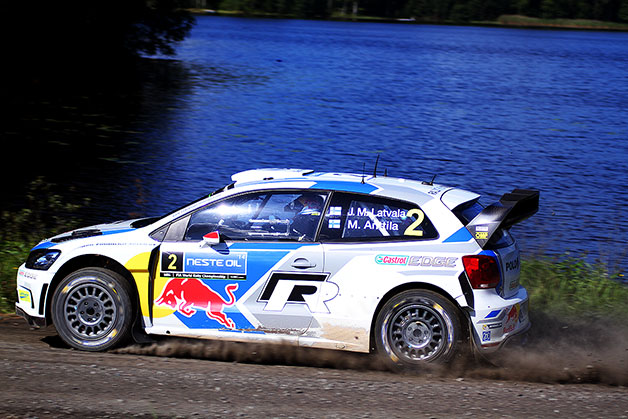
In the official program in Tuulilasi magazine, editor-in-chief Lauri Larmela bemoaned the lack of aural excitement and dynamic drama in the WRC currently, writing that the cars "drive like they're on rails. Very effective on the clock, but not so appealing to the spectators." The cause, as in F1, is "ecological pressures." On top of that, Larmela wrote, "New makes have joined the series, but still the title is effectively fought between drivers of one team."
He's talking about Volkswagen, which has become the equivalent Mercedes in Formula One. Current WRC driver's champion Sebastien Ogier has won five of eight rallies this year, his teammate Jari-Matti Latvala has won the other three, including the recently concluded Rally Finland.
Rules constraints are the culprit. The WRC Sporting Regulations mandate a car no longer than 12.8 feet, with a 1.6-liter turbocharged engine limited to about 300 horsepower. Teams get three engines per year and WRC has an exclusive fuel provider. Sole tire supplier Michelin offers two compounds, each team gets 24 tires per rally. Until this year, paddleshifters weren't allowed; Robert Kubica got special permission to use one because his right arm still isn't strong enough to work the lever, so beginning next year they'll be allowed for everyone.
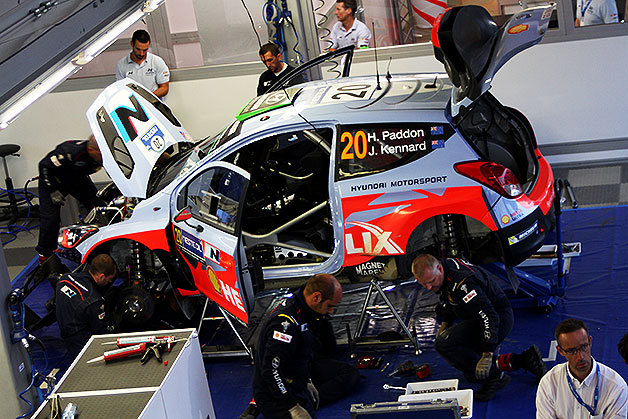
Out-of-competition testing is permitted, but stage reconnaissance is limited to two runs and only at an FIA-mandated maximum speed. For Rally Finland, that was 80 kph, a 10-kph increase over last year. In many places that's less than half the speed they'll race at, so experience here is invaluable.
Service stations at the beginning and end of every stage are gone, replaced by a 15-minute service in the morning before racing begins, 30 minutes in the afternoon, a 45-minute service at night. Only six crew members can work on the car at a time. If you break the car, you lose piles of time in the following stages before the next service.
The regs will change in 2017, among the considerations being cars up to D-segment, allowing more power and going to a fuel-flow formula so that manufacturers can run a variety of engines.
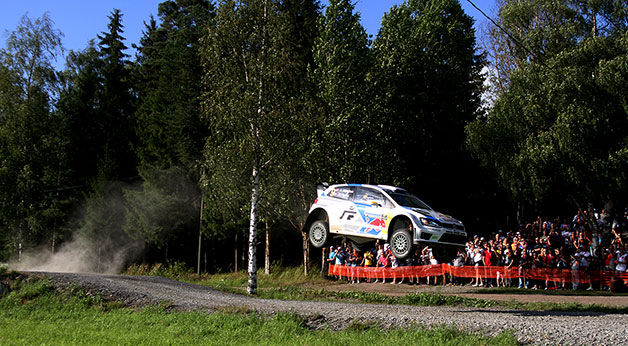
WRC Commission president Carlos Barbosa said, "If you paint all of the cars white, right now it's not possible to recognize which is which. We need to change that and we need to bring the spectacle back to our sport and make the cars more attractive." Heard that speech before? That might help sway the decision for Akio Toyoda – the Toyota chairman helicopetered into Rally Finland to watch, rumor being that Toyota will return in 2017 with the new regs.
VW Motorsport director Jost Capito doesn't feel the same way, though, saying, "The cars are very close in performance, the costs are reasonable and there is no reason to change the technical regulations because they are really good."
That's easy to say when, by all accounts, you have the largest budget in the field, you've hired the best engineers – and you just signed Marcus Gronholm as a test driver – and no other team can match you. For the moment.
The Neste Oil Rally Finland
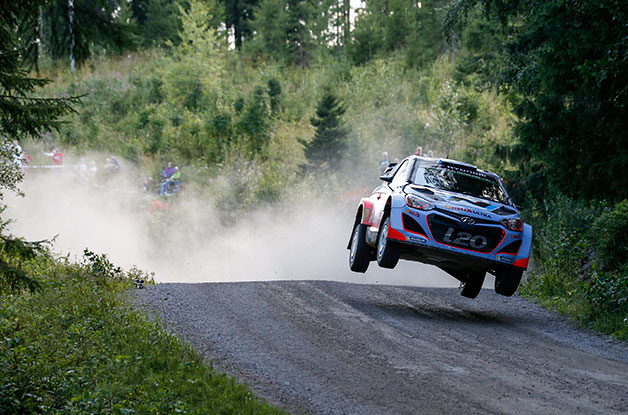
Whatever these cars have, Rally Finland is where they'll get to show it – it's nicknamed the Finnish Grand Prix because of the high speeds. Hyundai's three i20 racers would be driven by permanent pilot Neuville and co-driver Nicolas Gilsoul in the #7 car, rotating pilots Juho Hänninen with co-driver Tomi Tuominen in the #8 car and Hayden Paddon and John Kendall in the #20 car. Hyundai used one of its development "jokers" for the race, seeking improved engine reliability.
Let's clarify the bit about cars showing off: everyone does so behind VW. Jari-Matti Latvala led the race from its opening Shakedown stage, beating his World Champion teammate Sebastien Ogier by 3.6 seconds four days later. Of the 26 stages, Latvala won 13, Ogier won 12. Chris Meeke, the first Briton to be on the podium since the late Richard Burns in 2003, was 50.6 seconds back, the gaps growing much larger from there.
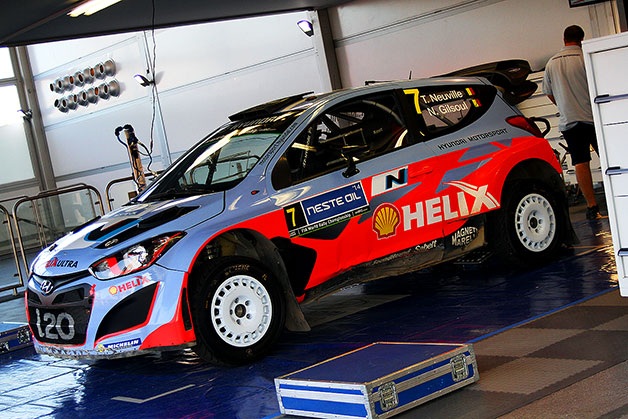
Hyundai got two cars to the finish in sixth and eighth, with Neuville crashing out on Friday. The Belgian slid wide through a turn and hit a rock on the day's first stage, knocking the car into a tree and damaging the rear wing. He drove through the lack of downforce, but scrutineers at the next checks discovered he damaged his roll cage in the accident. Unable to repair it in time, they prevented Neuville from continuing and he was out.
Hänninen began Day 2 in fourth, but a slow puncture early in the day led to a roll and dashboard damage that cost them more than a minute, on top of power steering issues – and they had to drive without a windscreen. He finished the day in ninth, but made up a few places over the next two days to finish in sixth.
Clean driving and few problems got Paddon as high as sixth on Day 3, but he was hit by power steering glitches on Day 4 and slid down to eighth at the finish.
Watching it from a portable chair in the Finnish woods, though, it wasn't as close as it appears. The VWs are clearly better; they go faster on straights and in corners, when others are lifting they stay on the throttle, they jump farther. If Latvala hadn't needed to limp after smashing a brake caliper on Day 3 he'd have laid more time into the field. The win puts him 44 points behind his teammate in the championship with five rounds remaining.
Hyundai's N-tent
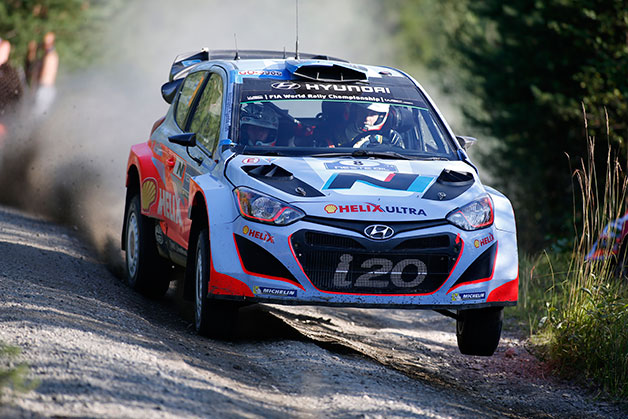
This is Hyundai's second foray into WRC, the first spanning from 1998 to 2003 – two years in the lower F2 category, four years at the top with a Hyundai Accent. Although that team was also called Hyundai Motorsport the car was prepped and run by a British company called Motor Sports Development. When the program ended, Hyundai didn't know much more about rallying than when it began. Said Thomas Villette, PR manager for the current Hyundai Motorsport, "None of the sporting knowledge came back to Hyundai."
Everything is in-house now, a global corporate push "To create a more dynamic image through motorsport" and attract young enthusiasts. The 20-month-old team is led by Michel Nandan, who a WRC title at Peugeot with Marcus Gronholm. He leads a force of 100 who come from WRC, F1 and German Touring Cars, and it moves as a family. "The whole team is here – we don't have an operation in Germany making parts," Vilette said.
After six months in development and six months of testing, they've continued testing in WRC competition. VW did the opposite, testing in private for a year. Asked what the team has got so far from its first season, Villette said organization cohesion is still a priority for the small squad. "We've learned a lot in one year, now we need to organize all the good ideas."
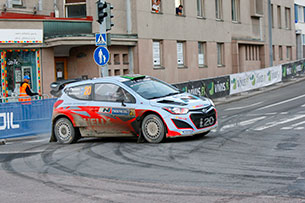
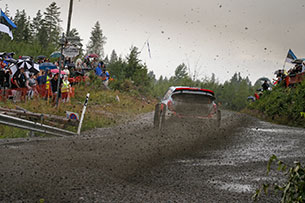
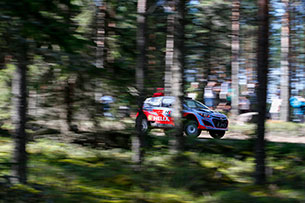
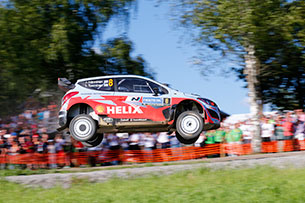
Yet this is all really about the N Performance sub-brand that, for the moment, Hyundai won't say much about. Villette confirmed that "'N' is what AMG is to Mercedes and M is to BMW," and we'll soon see the beginning of "a road car performance division." This won't be the warmed-over R-Spec cars we get here or the tape-and-rims specials like the i10 Sport or the Genesis coupe with a barking exhaust and sporty wheels in Germany. We find it interesting that none of the in-house performance arms mentioned with N – AMG, M, SRT, NISMO, etc – earned their motorsports credentials off-road. That's where the legends of companies like Subaru, Mitsubishi and Peugeot were born. Oh, and Quattro.
Villette said "Now there's a spirit for high performance being created in Namyang," the R&D center in South Korea that donated the "N" moniker, now that they've seen what professional motorsports engineers can do with a 1.6-liter turbo.
Collecting various bits of dialogue and development, we can see something tasty is possible. Reports have said the division will be based in Alzenau, a two-hour drive from Hyundai's technical center at the Nürburgring.
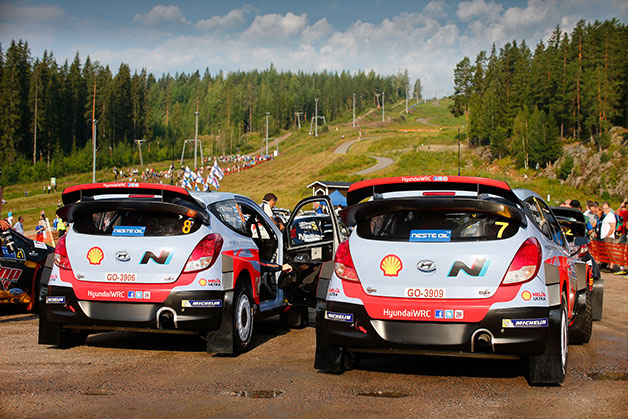
Nandan has said the i20 rally car exists "to connect the experience, engineering-wise, of the sport program with high performance concepts." The choice of WRC could partly have been because "Hyundai is particularly looking to enhance the way their cars handle in different conditions." Speculation is that the recently revealed 2015 i20 will the open the N account perhaps as soon as next year, and while no one would say anything about the sub-brand's North American prospects, it's been written that "it is designed to achieve additional growth in all markets in which the brand from South Korea operates." Even though WRC doesn't make the stars-and-stripes kids go crazy, to us, it wouldn't make sense for frugal Hyundai to spend a fortune marketing a performance brand only to skip its second-largest global market – a brand, remember, out to challenge the German goliaths that do make US kids go crazy. And there is that whole crate engine program thing...
With all that, we feel like a diner patron perusing a menu and thinking, "You don't have what I want but I see you have the ingredients." It'll be at least a year before we begin to understand what all of this really means, but whenever it comes, we look forward to the dish.
Meanwhile, after finishing second in the championship last year with the Qatar World Rally Team in a Ford Fiesta RS WRC, star driver Neuville says he wants to be fighting for podiums next year and challenging for the driver's title in 2016. He said he also wants the FIA to approve 100 more horsepower for the cars – a position that doesn't need any explanation at all.
It's the rookie year for the Hyundai Shell World Rally Team, run by Hyundai Motorsport out of Alzenau, Germany. The squad entered the season aiming for podiums in the second half and looking to get its three cars to the finish at every race for maximum development data. It's already outdone itself, Thierry Neuville scoring third places in Mexico – where he used a bottle of Corona to fill his radiator – and Poland.
Denis Giraudet told us that the rally's sternest challenge is not one of heart, though. Giraudet isn't part of Hyundai Motorsport, he was our guide and he's been in the sport as a co-driver for more than 30 years; he won Rally Finland with Juha Kankunnen in 1993 in a Toyota Celica Turbo 4WD. Giraudet said the race tests that particular confidence that comes from about 18 inches below the heart: "Here, you have to go all out. If there's a problem, it's usually between the steering wheel and the seat."
As In Formula One, So In World Rally

In the official program in Tuulilasi magazine, editor-in-chief Lauri Larmela bemoaned the lack of aural excitement and dynamic drama in the WRC currently, writing that the cars "drive like they're on rails. Very effective on the clock, but not so appealing to the spectators." The cause, as in F1, is "ecological pressures." On top of that, Larmela wrote, "New makes have joined the series, but still the title is effectively fought between drivers of one team."
He's talking about Volkswagen, which has become the equivalent Mercedes in Formula One. Current WRC driver's champion Sebastien Ogier has won five of eight rallies this year, his teammate Jari-Matti Latvala has won the other three, including the recently concluded Rally Finland.
Rules constraints are the culprit. The WRC Sporting Regulations mandate a car no longer than 12.8 feet, with a 1.6-liter turbocharged engine limited to about 300 horsepower. Teams get three engines per year and WRC has an exclusive fuel provider. Sole tire supplier Michelin offers two compounds, each team gets 24 tires per rally. Until this year, paddleshifters weren't allowed; Robert Kubica got special permission to use one because his right arm still isn't strong enough to work the lever, so beginning next year they'll be allowed for everyone.

Out-of-competition testing is permitted, but stage reconnaissance is limited to two runs and only at an FIA-mandated maximum speed. For Rally Finland, that was 80 kph, a 10-kph increase over last year. In many places that's less than half the speed they'll race at, so experience here is invaluable.
Service stations at the beginning and end of every stage are gone, replaced by a 15-minute service in the morning before racing begins, 30 minutes in the afternoon, a 45-minute service at night. Only six crew members can work on the car at a time. If you break the car, you lose piles of time in the following stages before the next service.
The regs will change in 2017, among the considerations being cars up to D-segment, allowing more power and going to a fuel-flow formula so that manufacturers can run a variety of engines.

WRC Commission president Carlos Barbosa said, "If you paint all of the cars white, right now it's not possible to recognize which is which. We need to change that and we need to bring the spectacle back to our sport and make the cars more attractive." Heard that speech before? That might help sway the decision for Akio Toyoda – the Toyota chairman helicopetered into Rally Finland to watch, rumor being that Toyota will return in 2017 with the new regs.
VW Motorsport director Jost Capito doesn't feel the same way, though, saying, "The cars are very close in performance, the costs are reasonable and there is no reason to change the technical regulations because they are really good."
That's easy to say when, by all accounts, you have the largest budget in the field, you've hired the best engineers – and you just signed Marcus Gronholm as a test driver – and no other team can match you. For the moment.
The Neste Oil Rally Finland

Whatever these cars have, Rally Finland is where they'll get to show it – it's nicknamed the Finnish Grand Prix because of the high speeds. Hyundai's three i20 racers would be driven by permanent pilot Neuville and co-driver Nicolas Gilsoul in the #7 car, rotating pilots Juho Hänninen with co-driver Tomi Tuominen in the #8 car and Hayden Paddon and John Kendall in the #20 car. Hyundai used one of its development "jokers" for the race, seeking improved engine reliability.
Let's clarify the bit about cars showing off: everyone does so behind VW. Jari-Matti Latvala led the race from its opening Shakedown stage, beating his World Champion teammate Sebastien Ogier by 3.6 seconds four days later. Of the 26 stages, Latvala won 13, Ogier won 12. Chris Meeke, the first Briton to be on the podium since the late Richard Burns in 2003, was 50.6 seconds back, the gaps growing much larger from there.

Hyundai got two cars to the finish in sixth and eighth, with Neuville crashing out on Friday. The Belgian slid wide through a turn and hit a rock on the day's first stage, knocking the car into a tree and damaging the rear wing. He drove through the lack of downforce, but scrutineers at the next checks discovered he damaged his roll cage in the accident. Unable to repair it in time, they prevented Neuville from continuing and he was out.
Hänninen began Day 2 in fourth, but a slow puncture early in the day led to a roll and dashboard damage that cost them more than a minute, on top of power steering issues – and they had to drive without a windscreen. He finished the day in ninth, but made up a few places over the next two days to finish in sixth.
Clean driving and few problems got Paddon as high as sixth on Day 3, but he was hit by power steering glitches on Day 4 and slid down to eighth at the finish.
Watching it from a portable chair in the Finnish woods, though, it wasn't as close as it appears. The VWs are clearly better; they go faster on straights and in corners, when others are lifting they stay on the throttle, they jump farther. If Latvala hadn't needed to limp after smashing a brake caliper on Day 3 he'd have laid more time into the field. The win puts him 44 points behind his teammate in the championship with five rounds remaining.
Hyundai's N-tent

This is Hyundai's second foray into WRC, the first spanning from 1998 to 2003 – two years in the lower F2 category, four years at the top with a Hyundai Accent. Although that team was also called Hyundai Motorsport the car was prepped and run by a British company called Motor Sports Development. When the program ended, Hyundai didn't know much more about rallying than when it began. Said Thomas Villette, PR manager for the current Hyundai Motorsport, "None of the sporting knowledge came back to Hyundai."
Everything is in-house now, a global corporate push "To create a more dynamic image through motorsport" and attract young enthusiasts. The 20-month-old team is led by Michel Nandan, who a WRC title at Peugeot with Marcus Gronholm. He leads a force of 100 who come from WRC, F1 and German Touring Cars, and it moves as a family. "The whole team is here – we don't have an operation in Germany making parts," Vilette said.
After six months in development and six months of testing, they've continued testing in WRC competition. VW did the opposite, testing in private for a year. Asked what the team has got so far from its first season, Villette said organization cohesion is still a priority for the small squad. "We've learned a lot in one year, now we need to organize all the good ideas."




Yet this is all really about the N Performance sub-brand that, for the moment, Hyundai won't say much about. Villette confirmed that "'N' is what AMG is to Mercedes and M is to BMW," and we'll soon see the beginning of "a road car performance division." This won't be the warmed-over R-Spec cars we get here or the tape-and-rims specials like the i10 Sport or the Genesis coupe with a barking exhaust and sporty wheels in Germany. We find it interesting that none of the in-house performance arms mentioned with N – AMG, M, SRT, NISMO, etc – earned their motorsports credentials off-road. That's where the legends of companies like Subaru, Mitsubishi and Peugeot were born. Oh, and Quattro.
Villette said "Now there's a spirit for high performance being created in Namyang," the R&D center in South Korea that donated the "N" moniker, now that they've seen what professional motorsports engineers can do with a 1.6-liter turbo.
Collecting various bits of dialogue and development, we can see something tasty is possible. Reports have said the division will be based in Alzenau, a two-hour drive from Hyundai's technical center at the Nürburgring.

Nandan has said the i20 rally car exists "to connect the experience, engineering-wise, of the sport program with high performance concepts." The choice of WRC could partly have been because "Hyundai is particularly looking to enhance the way their cars handle in different conditions." Speculation is that the recently revealed 2015 i20 will the open the N account perhaps as soon as next year, and while no one would say anything about the sub-brand's North American prospects, it's been written that "it is designed to achieve additional growth in all markets in which the brand from South Korea operates." Even though WRC doesn't make the stars-and-stripes kids go crazy, to us, it wouldn't make sense for frugal Hyundai to spend a fortune marketing a performance brand only to skip its second-largest global market – a brand, remember, out to challenge the German goliaths that do make US kids go crazy. And there is that whole crate engine program thing...
With all that, we feel like a diner patron perusing a menu and thinking, "You don't have what I want but I see you have the ingredients." It'll be at least a year before we begin to understand what all of this really means, but whenever it comes, we look forward to the dish.
Meanwhile, after finishing second in the championship last year with the Qatar World Rally Team in a Ford Fiesta RS WRC, star driver Neuville says he wants to be fighting for podiums next year and challenging for the driver's title in 2016. He said he also wants the FIA to approve 100 more horsepower for the cars – a position that doesn't need any explanation at all.
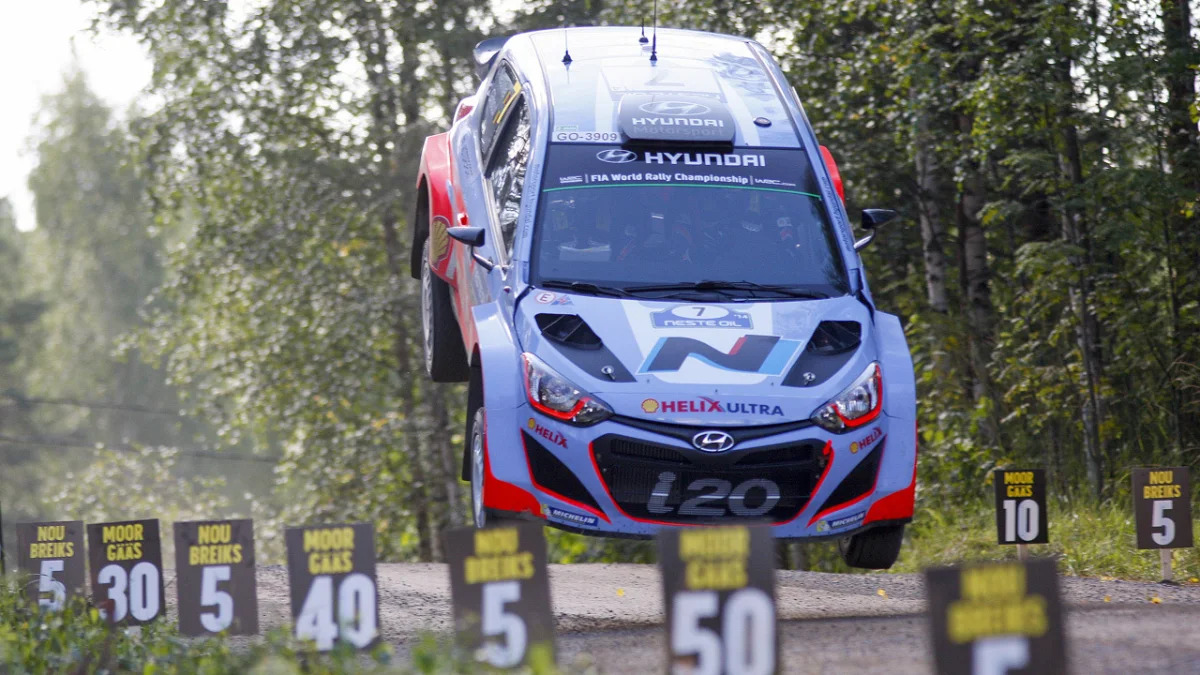









Sign in to post
Please sign in to leave a comment.
Continue